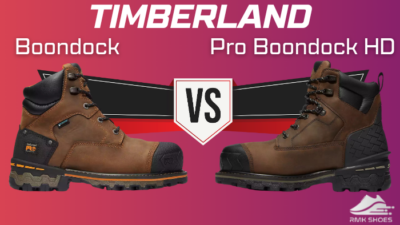The soles of your shoes play a vital role in the performance of your shoes and how effectively you can walk around and perform all necessary tasks.
Now, there are many different kinds of soles, and synthetic soles are one of them. However, I often get a question about synthetic soles: Are synthetic soles slippery?
I have carried out thorough research and tried on synthetic soles myself to get you the most accurate answer to this question.
Yes, synthetic soles can be slippery when they are newly bought, especially in wet and smooth surfaces. But as you wear them on different kinds of rough surfaces, over time they lose the slipperiness and provide great traction. You can also sand them or use sprays that will increase the traction.
So, what exactly are synthetic soles? How to reduce their slipperiness? Are they actually good? To know all the answers, keep reading this article till the very end.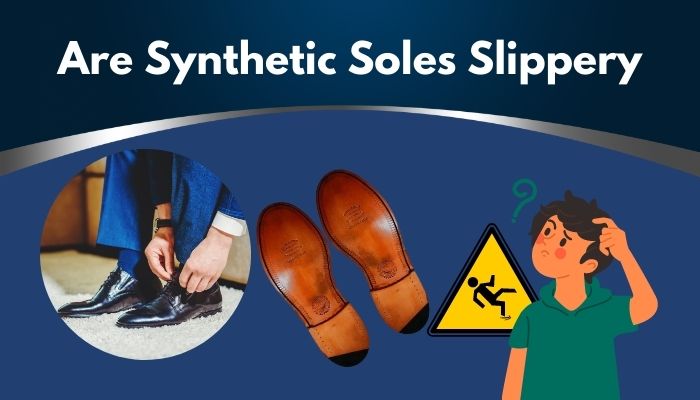
What Are Synthetic Soles
Synthetic soles are soles which are made of man-made materials which are not natural, like rubber or leather.
Synthetic soles are made using materials such as Poly Vinyl Chloride (PVC) and Ethyl Vinyl Acetate (EVA).
PVC soles are basically plastic polymers produced by a method known as direct injection; however, sometimes thick boards are also incorporated in the production process. They have a decent amount of flexibility and are resistant to abrasions, so they do not leave scuff marks.
EVA is used second most frequently in the production of synthetic soles. Since EVA is somewhat more comfortable, softer, and more flexible than other materials, it is frequently used in the production of soles.
Synthetic soles are often used in running shoes, different kinds of boots and sneakers.
Check out our separate post: Are Rain Boots Slip Resistant.
Are Synthetic Soles Slippery
Slippery shoes can be a real hassle sometimes, disrupting your balance and increasing chances of slips and accidents. So, are synthetic soles slippery? Are they safe?
Well, synthetic soles can be a little slippery when they are newly bought or when you use them on wet and slippery surfaces. But other than that, they are not very slippery.
In fact, some people claim that their synthetic soles are not slippery at all.
So, the truth is, it depends on where you wear them, their quality, and the weather when you have your synthetic soled shoes on that will determine if they are slippery or not.
In general, synthetic soles provide great stability and traction. So, even if your synthetic soles are slightly slippery at first, over time the slipperiness will go away.
You can also wear them on rough surfaces, such as concrete, rocky, or metal surfaces, and they will lose the slippery nature and improve the traction and grip greatly.
You can also find different tools in the market that can help reduce or completely remove the slipperiness from your synthetic soles.
Follow our guide to know Are Tactical Boots Slip-Resistant.
Do you wanna know how to make them non-slippery? I have mentioned that below.
How To Reduce The Slipperiness Of Synthetic Soles
Now that you know that synthetic sole shoes can be slippery at times, you might ask if there are any ways that the slipperiness can be reduced or removed.
When you initially start wearing a pair of shoes with synthetic soles, you may find that they are just somewhat slippery; nevertheless, after some time has passed, the soles should become more balanced and useful for use in any environment.
Given that you don’t walk on slick surfaces, you really shouldn’t sense that your synthetic soles are slippery at all.
If you feel that the synthetic soles of your shoes are too slick to wear, there are a few simple adjustments you may make to tackle this issue. And I have mentioned them below.
Follow our guide on how to Fix Heel Slippage In Cowboy Boots
Walk Around In Them
Simple as it may sound, walking around in your synthetic sole shoes will definitely help with the slipperiness.
If you walk around in them and break them in, over time the soles will get scruffed and the texture on their surface will increase.
As a result, the friction and traction of the soles will increase and they will not be slippery anymore.
After you have broken in your shoes in the most suitable way possible, synthetic soles often become more comfortable to walk on. Because of this, you should wear the shoes often and ensure that they are properly broken in, then they won’t be as slippery.
Walk On Hard And Rough Surfaces
Walking on hard and rough surfaces will also help reduce the slipperiness of your synthetic soles. So, if your soles are slippery, then you should walk on hard and rough surfaces such as concrete or rocky, hard surfaces.
Walking on harsh surfaces will increase the texture at the bottom of the soles, as a result, the friction and traction of your soles will increase. The slipperiness will also go away.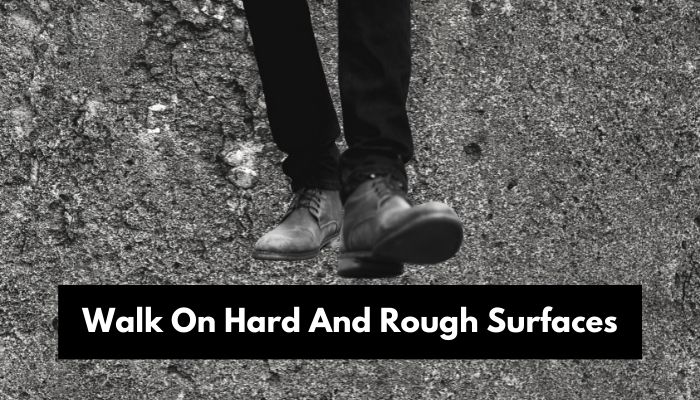
In fact, even if your synthetic soles are not slippery in the beginning, you can still do this as it will toughen up your soles and increase their traction, so you’ll have a better experience with the synthetic soles regardless of whether they were slippery to begin with or not.
You may also like Are Air Max Nonslip Shoes.
Scruff Them With Sandpaper
Another way to increase the friction and reduce the slipperiness of your synthetic soles is by using sandpaper.
You can get sandpaper from any convenience store near your house, and all you need to do is scrub the bottoms of your synthetic soles using the sandpaper.
The harsh texture of the sandpaper will cause the base of the soles to abrade, if you do this about three to four timeless with gaps in between, it should be enough to get rid of any and all slipperiness from your synthetic soles.
It is highly cost effective and efficient, so you should definitely give this a try.
Use Hairspray On Them
This last one is a temporary solution that you can try out on the go if you don’t have much time in your hands, and this is using hairspray on the base of your synthetic soles.
To make your synthetic shoe bottoms less slippery while you wear them, spray them with multiple coats of hair spray before putting on your shoes. This will help prevent you from slipping and falling.
When using the spray, wait for the first coat of hair spray that you sprayed on the soles to dry before applying the second coat of hair spray to the synthetic soles of the shoes. Once the first coat of hair spray has dried, you may apply the second coat.
The synthetic sole material will undergo a chemical reaction with the chemicals included in the hair spray, which will cause the material to thicken to the point where it will be less slippery and more balanced on the ground.
Follow our separate guide on how to Clean The Soles of Dance Shoes.
What Are The Benefits Of Synthetic Soles
Now that you know how to get rid of the slipperiness from your synthetic soles, why not know about the benefits of synthetic soles?
Here I have included the benefits or advantages of synthetic soles that make them a great alternative to shoes with natural soles.
Cheap
Shoes that have synthetic soles are much cheaper than shoes with soles made using leather. Since they are manufactured on a larger scale, the cost gets reduced highly and as a result you can get them at much cheaper prices.
Long Lasting
Because of the continuous direct contact with the ground, the soles of the shoes are the section of the shoes that have the greatest chances to wear out and get damaged first.
However, if your shoes have synthetic soles you won’t have to worry about your shoes falling apart at inconvenient times since the quality of these soles is high enough to last you for a long time.
Shoe soles that are made of synthetic materials have all of the characteristics of soles that are designed to survive for a long period.
Since they are constructed with remarkable durability, the soles of these shoes will not rub or wear down beneath your feet as soon as you have them or at any point in the near future. As a result, you will be able to enjoy wearing these shoes for a very long time.
Water Resistant
Synthetic soles are water resistant, which means that they won’t get damaged by water and other aqueous fluids. This is a problem people often face with soles made of natural resources, such as leather.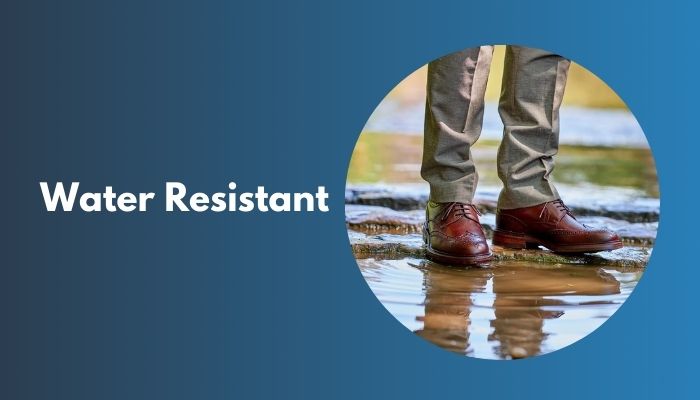
So, as a result, when you use shoes that have synthetic soles, you won’t have to worry about them getting damaged by water, rain, or puddles.
Comfortable & Flexible
One of the primary reasons why people like synthetic soles is because they provide a nice and cushioned sensation when worn.
Shoe wearers get the optimum comfort and stability that they need beneath their footwear as a result of the unique and higher quality of the materials that are used in the production of synthetic soles.
When it comes to the feet, synthetic soles are incredibly elastic and flexible, regardless of when you get them or what conditions you wear them in.
Even though synthetic soles have a rigid construction that is designed to endure for a very long time, they are nonetheless highly flexible and fluid in a manner that will bring a great deal of delight to you.
What Are The Drawbacks Of Synthetic Soles
Now that you know the benefits of getting shoes with synthetic soles, what are the disadvantages of getting synthetic soled shoes?
Well, there are not as many disadvantages but only a few, and they are stated below.
Slippery
As you know by now, sometimes the soles that are synthetic can be slippery, especially when new or in wet conditions.
This can lead to lower stability, increased chances of slipping, and potential accidents.
However, this is not a problem that cannot be resolved as you can use different diy methods to increase the friction and get rid of the slipperiness from your synthetic soles.
Non Biodegradable
As people are being more aware of their impact on the environment, they want and need for more sustainable and eco friendly products is increasing.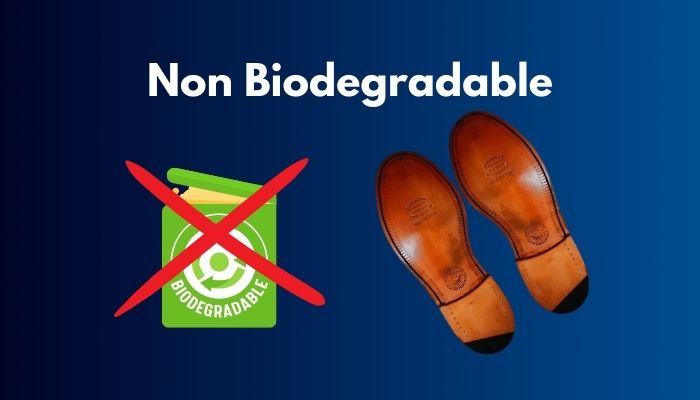
This is one of the major disadvantages of synthetic soles, they are non biodegradable. This means they will not break down fully, or take a really, really long time to break down naturally.
So, they are not eco friendly.
Conclusion
Synthetic sole shoes are an excellent alternative to shoes with soles made using natural materials. Even though they may get a bit slippery at times, it is not always the case.
And even if they are slippery in the beginning, you can easily get rid of the slipperiness over time.
I hope the methods to reduce the slipperiness of synthetic soles will help you do so with yours and now you can make an informed decision about whether you want to purchase shoes that have synthetic soles.
What topic would you like for me to cover next? Let me know in the comments below.

